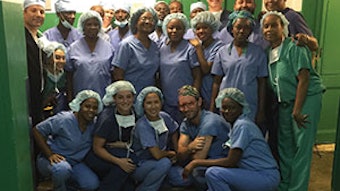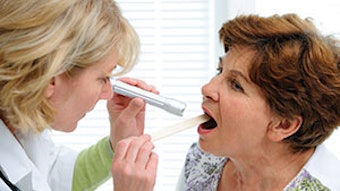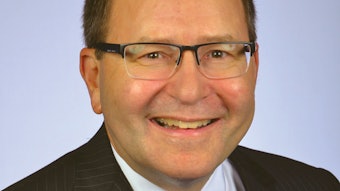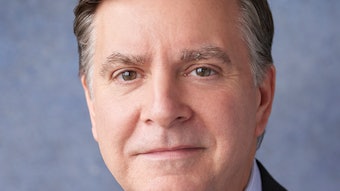Clinical Practice Guideline: Improving Nasal Form and Function after Rhinoplasty
The primary purpose of the “Clinical Practice Guideline: Improving Nasal Form and Function after Rhinoplasty” is twofold: 1. to fill the current void of multidisciplinary clinical practice guidelines available to clinicians and patients and 2. to provide evidence-based recommendations for clinicians, who either perform rhinoplasty or are involved in the care of a rhinoplasty candidate, to optimize patient care, promote effective diagnosis and therapy, and reduce harmful or unnecessary variations in care.

The primary purpose of the “Clinical Practice Guideline: Improving Nasal Form and Function after Rhinoplasty” is twofold: 1. to fill the current void of multidisciplinary clinical practice guidelines available to clinicians and patients and 2. to provide evidence-based recommendations for clinicians, who either perform rhinoplasty or are involved in the care of a rhinoplasty candidate, to optimize patient care, promote effective diagnosis and therapy, and reduce harmful or unnecessary variations in care.
The 2017 guideline was chaired by Lisa E. Ishii, MD, MHS, with Travis T. Tollefson, MD, MPH, and Gregory J. Basura, MD, PhD, serving as assistant chairs, and Richard M. Rosenfeld, MD, MPH, as the methodologist.
“Rhinoplasty ranks among the most commonly performed cosmetic procedures in the United States, with over 200,000 procedures reported in 2014,” said Dr. Ishii. “And prior to these guidelines, limited literature existed on standard pre- and post-management care for patients undergoing this procedure. These guidelines are crucial in building unanimity regarding the peri- and post-operative strategies to maximize patient safety and optimize surgical results for patients.”
This is the first evidence-based clinical practice guideline developed to address rhinoplasty with the goal of providing clinicians, and those involved in the management of these patients, with a logical framework to improve patient care by using a specific set of focused recommendations based upon an established and transparent process that considers levels of evidence, harm-benefit balance, and expert consensus.
“We are particularly delighted to have had input and collaboration from all stakeholders to develop guidelines that emphasize both form and function when performing rhinoplasty,” said Dr. Ishii.
The guideline is endorsed by the American Academy of Facial Plastic and Reconstructive Surgery (AAFPRS), American Society of Plastic Surgeons (ASPS), American Academy of Sleep Medicine (AASM), American Rhinologic Society (ARS), Society of Otorhinolaryngology and Head-Neck Nurses (SOHN), American Society for Aesthetic Plastic Surgery (ASAPS), American Academy of Pediatrics (AAP), and The Rhinoplasty Society.
The full guideline as well as other resources are available at http://www.entnet.org/rhinoplastyCPG and in Otolaryngology–Head and Neck Surgery as published at otojournal.org.
The guideline is intended for any clinician or individual, in any setting, involved in the management of patients of rhinoplasty. The target patient population is all patients age 15 years and older. The guideline is intended to focus on knowledge gaps, practice variations, and clinical concerns associated with this surgical procedure, and is not intended to be a comprehensive reference for improving nasal form and function after rhinoplasty.
Guideline recommendations
Communicating expectations
Clinicians should ask all patients seeking rhinoplasty about their motivations for surgery and their expectations for outcomes, should provide feedback as to whether those expectations are a realistic goal of surgery and should document this discussion in the medical record.
Comorbid conditions
Clinicians should assess rhinoplasty candidates for comorbid conditions that could modify or contraindicate surgery that include obstructive sleep apnea, body dysmorphic disorder, bleeding disorders, or chronic use of topical vasoconstrictive intranasal drugs.
Nasal airway obstruction
The surgeon, or the surgeon’s designee, should evaluate the rhinoplasty candidate for nasal airway obstruction during the preoperative assessment.
Preoperative education
The surgeon, or the surgeon’s designee, should educate rhinoplasty candidates regarding what to expect after surgery, how surgery might affect the ability to breathe through the nose, potential complications of surgery, and the possible need for future nasal surgery.
Counseling for obstructive sleep apnea patients
The clinician, or the clinician’s designee, should counsel rhinoplasty candidates with documented obstructive sleep apnea (OSA) about the impact of surgery on nasal airway obstruction and how OSA might affect perioperative management.
Managing pain and discomfort
The surgeon, or the surgeon’s designee, should educate rhinoplasty patients before surgery about strategies to manage discomfort after surgery.
Outcome assessment
Clinicians should document patient satisfaction with their nasal appearance and with their nasal function at a minimum of 12 months after rhinoplasty.
The guideline development group recommended against certain actions. These include:
Postoperative antibiotics
When a surgeon, or the surgeon’s designee, chooses to administer perioperative antibiotics for rhinoplasty, he or she should not routinely prescribe antibiotic therapy for a duration of more than 24 hours after surgery.
Nasal packing
Surgeons should not routinely place packing in the nasal cavity of rhinoplasty (with or without septoplasty) patients at the conclusion of surgery.
The panel group made the following statement an option:
Perioperative steroids
The surgeon, or the surgeon’s designee, may administer perioperative systemic steroids to the rhinoplasty patient.
Guideline authors
Lisa E. Ishii, MD, MHS; Travis T. Tollefson, MD, MPH; Gregory J. Basura, MD, PhD; Richard M. Rosenfeld, MD, MPH; Peter J. Abramson, MD; Scott R. Chaiet, MD, MBA; Kara S. Davis, MD; Karl Doghramji, MD; Edward H. Farrior, MD; Sandra A. Finestone, PsyD; Stacey L. Ishman, MD, MPH; Robert X. Murphy, Jr., MD, MS, CPE; John G. Park, MD, FCCP, FAASM; Michael Setzen, MD; Deborah J. Strike, BSN, CORLN; Sandra A. Walsh, BS (MdT); Jeremy P. Warner, MD; and Lorraine C. Nnacheta, MPH.
AAO-HNSF Guideline development process and the obligations associated with the guideline recommendations are documented in the Clinical Practice Guideline Development Manual, Third Edition: a quality-driven approach for translating evidence into action. (http://oto.sagepub.com/content/148/1_suppl/S1.long)
Disclaimer
The clinical practice guideline is not intended as the sole source of guidance in managing candidates for rhinoplasty. Rather, it is designed to assist clinicians by providing an evidence-based framework for decision-making strategies. The guideline is not intended to replace clinical judgement or establish a protocol for all individuals with this condition and may not provide the only appropriate approach to diagnosing and managing this program of care. As medical knowledge expands and technology advances, clinical indicators and guidelines are promoted as conditional and provisional proposals of what is recommended under specific conditions but are not absolute. Guidelines are not mandates. These do not and should not purport to be a legal standard of care. The responsible physician, in light of all circumstances presented by the individual patient, must determine the appropriate treatment. Adherence to these guidelines will not ensure successful patient outcomes in every situation. The AAO-HNSF emphasizes that these clinical guidelines should not be deemed to include all proper treatment decisions or methods of care, or to exclude other treatment decisions or methods of care reasonably directed to obtaining the same results.
New resources for patient information
The AAO-HNSF is providing Members with access to downloadable patient health information on the guideline for improving nasal form and function after rhinoplasty, including instructions on how to customize the handouts with your office or institutional logo at http://www.entnet.org/rhinoplastyCPG.

















